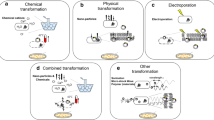Abstract
The kinetics of glutaraldehyde inactivation of a protoplasmic (β-fructofuranosidase) and an extracytoplasmic (acid phosphatase) enzyme inSaccharomyces rouxii cells were studied at pH 5.5 and 30°C. The effects of glutaraldehyde concentration (0.5–3%), pH value, and temperature were surveyed by varying the fixation conditions. Cells from 1- to 10-day cultures retained 50–75% of their acid phosphatase activity and 15–24% of their β-fructofuranosidase activity after 1-h exposures to 0.5% glutaraldehyde. The surviving β-fructofuranosidase activity remained physically cryptic and was revealed only after further membrane perturbation with ethyl acetate. This crypticity barrier disappeared after overnight incubation of the treated cells at 4°C, with or without added glutaraldehyde, during which time the enzyme was resistant to further inactivation. The velocity ratio for raffinose versus sucrose, as substrate, decreased in treated cells, and changes inV max andK m were indicative of frank destruction of some enzyme molecules as well as modification of survivors. A comparable set of changes was also generated by treating cell-free extract with glutaraldehyde. Glutaraldehyde (0.5%) killed all yeast cells at 30°C within 5 min; at 4°C survival rates were quite high—81% after 15 min and 65% after 1 h. The bearing of these examples of enzyme inactivation, permeability barrier abolition, and structural stabilization on the general problems of yeast cytochemistry is discussed.
Similar content being viewed by others
Literature Cited
Arnold, W. N. 1974. Expression of cryptic β-fructofuranosidase inSaccharomyces rouxii. Journal of Bacteriology120:886–894.
Arnold, W. N., Garrison, R. G. 1979. An Fe3+-activated acid phosphatase inSaccharomyces rouxii. Journal of Biological Chemistry254:4919–4924.
Arnold, W. N., Garrison, R. G. 1979. Isolation and characterization of protoplasts fromSaccharomyces rouxii. Journal of Bacteriology137:1386–1394.
Arnold, W. N., Lacy, J. S. 1977. Permeability of the cell envelope and osmotic behavior inSaccharomyces cerevisiae. Journal of Bacteriology131:564–571.
Dixon, M., Webb, E. C. 1958. Enzymes. New York: Academic Press.
Garrison, R. G. 1981. Vegetative ultrastructure, chap. 7. In: Arnold, W. N. (ed.), Yeast cell envelopes: Biochemistry, biophysics, and ultrastructure, vol. 2. Boca Raton, Florida: CRC Press.
Monsan, P., Puzo, G., Mazarguil, H. 1975. Étude du mécanisme d'établissement des liaisons glutaraldéhyde-protéines. Biochimie57:1281–1292.
Pappagianis, D., Phaff, H. J. 1956. Delayed fermentation of sucrose by certain haploid species ofSaccharomyces. Antonie van Leeuwenhoek Journal of Microbiology and Serology22:353–370.
Peters, K., Richards, F. M. 1977. Chemical cross-linking: Reagents and problems in studies of membranes structure. Annual Review of Biochemistry46:523–551.
Wilkinson, G. N. 1961. Statistical estimation in enzyme kinetics. Biochemical Journal80:324–332.
Author information
Authors and Affiliations
Rights and permissions
About this article
Cite this article
Arnold, W.N. Glutaraldehyde-fixation of yeast cells: Kinetics of a model system for enzyme cytochemistry. Current Microbiology 6, 305–308 (1981). https://doi.org/10.1007/BF01566882
Issue Date:
DOI: https://doi.org/10.1007/BF01566882




